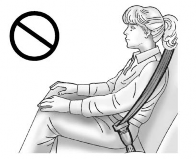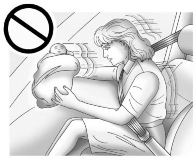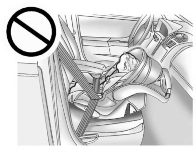< Previous | Contents | Next >
![]()

{ Warning
Never allow a child to wear the seat belt with the shoulder belt behind
their back. A child can be seriously injured by not wearing the
lap-shoulder belt properly. In a crash, the child would not be
restrained by the shoulder belt. The child could move too far forward
increasing the chance of head and neck injury. The child might also
slide under the lap belt. The belt force would then be applied right
on the abdomen. That could cause serious or fatal injuries. The
shoulder belt should go over the shoulder and across the chest.

![]()
Infants and Young Children
Everyone in a vehicle needs
protection! This includes infants and
all other children. Neither the distance traveled nor the age and size of the
traveler changes the need, for
everyone, to use safety restraints. In fact, the law in every state in the
United States and in every Canadian
province says children up to some age must be restrained while in a vehicle.
![]()

{ Warning
Children can be seriously injured or strangled if a shoulder belt is
wrapped around their neck. The shoulder belt can tighten but
cannot be loosened if it is locked. The shoulder belt locks when it is pulled all the way out of the
retractor. It unlocks when the
shoulder belt is allowed to go all
the way back into the retractor, but it cannot do this if it is wrapped
around a child’s neck. If the
shoulder belt is locked and
tightened around a child’s neck, the only way to loosen the belt is to
cut it.
Never leave children unattended in a vehicle and never allow children
to play with the seat belts.
Every time infants and young children ride in vehicles, they should have the protection provided by appropriate
child restraints. Neither the vehicle's
seat belt system nor its airbag system is designed for them.
![]()
![]()

Children who are not restrained properly can strike other people,
or can be thrown out of the vehicle.

{ Warning
![]()
SEATS AND RESTRAINTS 99
Never hold an infant or a child while riding in a vehicle. Due to crash forces, an infant or a child will become so heavy it is not
possible to hold it during a crash. For example, in a crash at only
40 km/h (25 mph), a 5.5 kg (12 lb) infant will suddenly become a
110 kg (240 lb) force on a person's arms. An infant or child should be
secured in an appropriate restraint.


{ Warning
Children who are up against,
or very close to, any airbag when it inflates can be seriously injured or killed. Never put a rear-facing child restraint in the front outboard seat.
Secure a rear-facing child restraint in a rear seat. It is also better to
secure a forward-facing child
restraint in a rear seat. If you must secure a forward-facing child
restraint in the front outboard seat, always move the front passenger
seat as far back as it will go.
Child restraints are devices used to
restrain, seat, or position children in the vehicle and are sometimes called child seats or car seats.
There are three basic types of child restraints:
. Forward-facing child restraints
. Rearward-facing child restraints
. Belt-positioning booster seats The proper child restraint for your
child depends on their size, weight, and age, and also on whether the
child restraint is compatible with the vehicle in which it will be used.
![]()